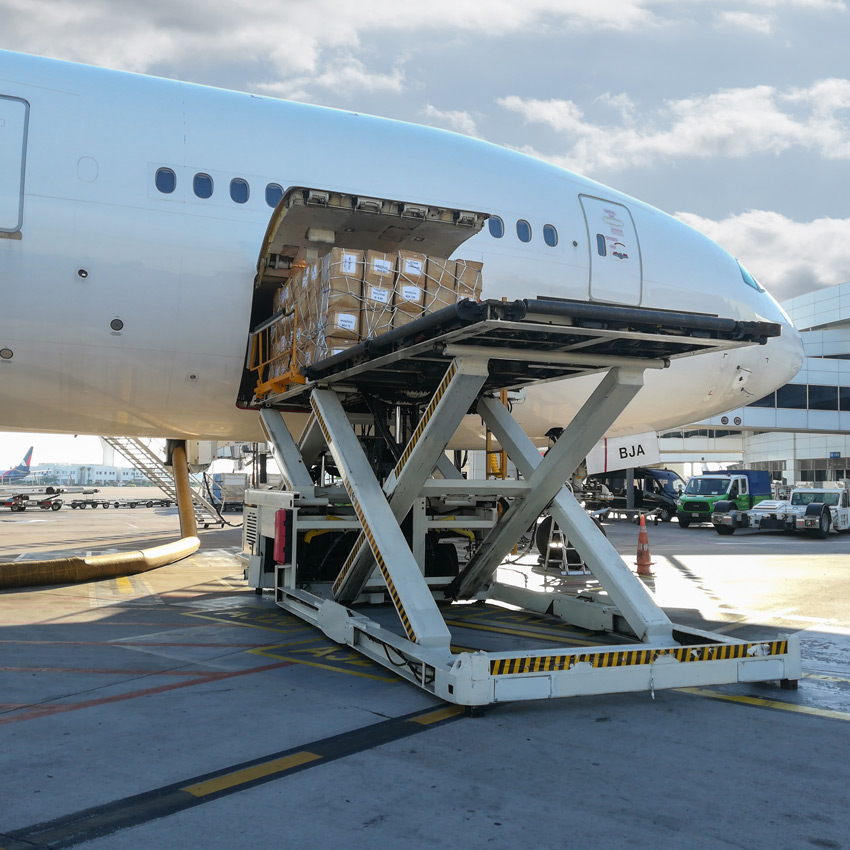
Air freight from the UK to the US
Thinking of using air freight for your shipments from the UK to US? I don’t blame you. It’s the quickest way to get valuable cargo across the Atlantic, which can open many previously unachievable business opportunities.
Over 22 million passengers moved between the two nations in 2019, so there are plenty of planes for your goods to travel on. With the travel restrictions imposed because of covid-19 at an end, we are seeing travelling numbers getting close to those heights again.
Increased passenger capacity equals increased shipping capacity.
So how can you further capitalise on this trade lane, which saw USD 119.58bn in good moved in 2021?
Transit Times
So, we know air freight is quicker than sea freight. But how much quicker?
Flying between the UK and US generally takes between seven and 11 hours. A huge decrease in the 11-34 days (depending on ports) it takes for cargo to move across the ocean, but it’s not quite that simple.
Customs declarations and other regulatory requirements mean it’ll probably take three-four days to complete the whole process. Which is still much quicker than sea freight, where you might be waiting a week for items to be released from port.
Customs checks can sometimes be longer if you don’t have a good provider who is experienced in the USA as it has more forensic procedures than most other nations.
Schedule Times
In normal market conditions, there are numerous flights between the UK and US every day. Scheduling specific planes is not an issue, because there are so many.
As a bonus, if you miss one the next plane heading that way will no doubt be departing very soon. So, your goods are likely to be setting off shortly after the intended flight… although there are no guarantees! We really would advise your goods are all in order to make the proposed flight.
With scheduled flights into the US so regular, the main challenge in 2023 is organisation. The best course of action is to be two-three weeks ahead of your freight and make bookings that far in advance. With that level of planning, booking appropriate flight times is unlikely to be an issue.
Packing goods
When packing up goods for air cargo you need to ensure that they are sturdy. Will the goods survive unharmed if wedged between or under others?
If possible, it is preferable to pack them no higher than 160cm, so they can fit on wide-bodied aircraft. This is the maximum height possible to send goods on planes with passengers, which will keep the cost down. For narrow-bodied aircraft, the restriction is 120cm. Dimensions more than that and your goods will have to fly on a cargo plane, which will cost more.
It’s also preferable to pack your goods tightly. Due to the way rates are calculated, tightly packing cargo, particularly when individual items are light, is an effective way to reduce costs.
Chances are over the course of a shipment, goods are going to be rocked, knocked, and shook about. So, make sure items are secure. Cutting corners here is likely to result in damaged cargo at the other end. Any money you might have saved with cheap packaging will be lost in the cargo which is broken.
Which airports should I use for cargo in the UK and USA?
This largely depends on where the goods are coming from in the UK and where they’re going to in the US. Then it’s about pairing up an airport which makes the most logistical sense, with one that has the right schedules and prices.
Let’s look at the most prominent airports on both sides of the Atlantic. First the UK:
Heathrow Airport
(LHR)
The UK’s busiest airport with 80.9 million passengers in 2019.
1,587,558 tonnes of cargo through the terminal in 2019, more than any other in the UK.
Highest volume of aircraft heading to the States. Many flights per day, to a range of airports all over the country.
East Midlands Airport
(EMA)
The UK’s largest dedicated cargo operation, with 440,000 tonnes of cargo moving through it. Prominent for large goods which require specialist cargo aircraft.
On average it is the most geographically convenient.
Reachable within 4 hours by truck for 90% of the UK.
Manchester Airport
(MAN)
The busiest airport in the North of England, with 29.4 million passengers in 2019.
Smaller cargo operation, with 108,382 tonnes through the terminal in 2019.
Several flights a day to key American cities.
Gatwick Airport
(LGW)
UK’s second busiest airport with 46.6 million passengers in 2019.
Easily accessible from London and several flights a day to key American cities.
Typically, more than 100,000 tonnes of cargo moving through per annum.
Now let’s look at some of the most common options for arrival airports in USA:
Hartsfield-Jackson Atlanta Airport
(ATL)
The busiest airport in the world in terms of passenger numbers. 107.4 million in 2019.
5 runways in operation.
685,444 tonnes of cargo through the terminal in 2021.
Chicago O'Hare Airport
(ORD)
A staggering 8 runways!
Over 2 million tons of cargo go through the airport every year, valued at over $200 billion, making it the number 1 globally in terms of cargo value.
Very close to WTA USA’s headquarters and highly reputable customs team.
Los Angeles Airport
(LAX)
Nearly 43 million passengers in 2019.
Majority of traffic is internal flights to other States.
2,974,073 tons of cargo through the airport in 2021, with imports and exports valued at $118 billion.
There are plenty of other options for importing cargo into the United States. Thanks to our extensive partnerships and strong relationships with key airlines, any US international airport is possible for us to send goods to at WTA. But the ones listed below are crucial in terms of cargo volume and value.
Again, it’s about picking one which is the best marriage of price, schedules and proximity to the final destination.
Atlanta
Boston
Chicago
Houston
Los Angeles
Pittsburgh
Seattle
San Francisco
Documentation requirements
There are certain documents which are a necessity for all air cargo, such as the airway bill, packing list and commercial invoice. The accuracy of these forms is essential to avoid possible penalty charges and delays. It’s also crucial they are submitted on time.
But there are many other documents that might need to be completed. Particularly if you’re shipping dangerous goods.
Cargo screening
Like when taking luggage on holiday, air freight cargo is screened before take-off to ensure the security of the goods and the safety of those onboard. As most air freight travels on planes with passengers, there are no shortcuts.
There are three main ways of screening goods: x-ray, Explosives Trace Detection (ETD) and hand searching. The most common is the x-ray machine. Just like the security systems for passengers’ suitcases, but bigger. At the airport before boarding the plane, your packaged goods will pass through whilst being inspected by a security officer.
Security is stricter than sea freight, as the potential for human catastrophe is greater. Some goods cannot be transported on aircraft at all. As you would expect, the UK and USA have some of the strictest screening procedures in the world, so goods need to be thoroughly compliant with the documentation submitted.
Customs requirements
Customs requirements are a necessary obstacle for shipping internationally, regardless of transport method.
If you’re using sea freight already then nothing will change, other than the location the checks are done. Although an increasing number of customs procedures are not done at the point of entry these days.
Like most other countries, the UK and US use the internationally recognised HS code for identifying cargo types. Once you have this code it becomes very easy to establish what duty, if any, needs to be paid on your goods.
You can learn more about the US Harmonised System code system here, or you can search directly for your products' code here.







